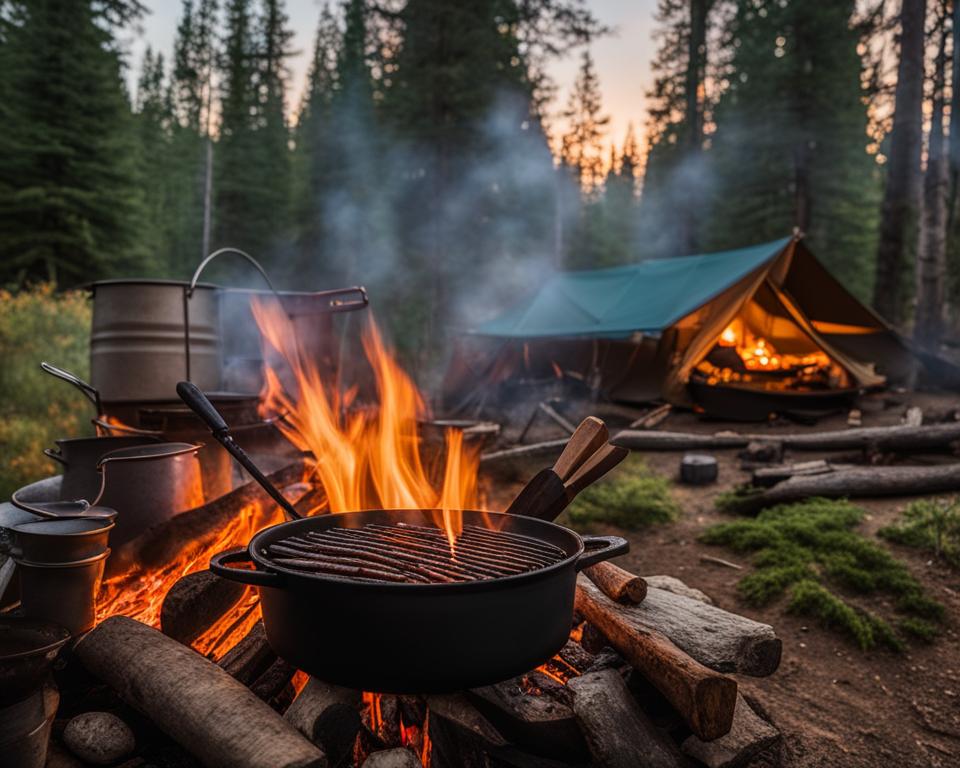Gearing up for a wilderness adventure means more than just pitching tents and choosing the right hiking boots; it’s also about bringing together the camp cooking essentials that will fuel your journey. Whether you’re a savvy outdoor chef or new to the campfire cooking scene, having the right camping cookware tips at your fingertips can elevate your outdoor cooking guide from basic to extraordinary.
For many, a camping trip is an opportunity to disconnect from the digital world and reconnect with nature. Yet, amidst the serenity, the wilderness calls for pragmatism, particularly when it comes to mealtime. This introduction will delve into the overlooked art of curating your camp kitchen, emphasizing why a thoughtful approach to your camping diet recommendations is as important as your itinerary.
A hearty meal by the campfire not only warms the soul but also replenishes vital energy reserves. From choosing eco-friendly materials to packing nutrient-dense snacks, every little detail can have a sizable impact on your overall camping experience. Let’s embark on a culinary adventure that promises to keep spirits high and bellies full, under the open sky.
Setting up your campsite kitchen successfully demands foresight. From lightweight utensils to portable stoves, the choices are endless. Whether you’re prepping for a weekend getaway or a weeklong odyssey into the great outdoors, this guide aims to prepare you for the unique joys and challenges of campfire cuisine.
Key Takeaways
- Selecting appropriate cookware is critical for managing weight and space without sacrificing meal quality.
- Understanding the nutritional needs for outdoor activities will inform your choices for a beneficial camping diet.
- Eco-friendly practices in meal prep and cleanup not only protect the environment but also enhance your camping experience.
- The right tools can turn a rudimentary camp meal into a delightful dining experience, with minimalistic gadgets providing maximum utility.
- For every outdoor chef, efficiency and simplicity are the key ingredients for a seamless and enjoyable camp cooking venture.
Choosing the Right Camping Cookware
Preparing meals in the great outdoors is a quintessential part of the camping experience, but the enjoyment and ease of outdoor cooking largely depend on the types of cookware you select. The choice can greatly impact not just the taste of your food, but also how you pack and transport your cooking gear. In this guide, we’ll dive into the details about various camping cookware materials, space-saving cookware designs, and the pros and cons of non-stick camping pots compared to traditional options, ensuring your selection is tailored to durable and practical outdoor cooking gear.
Materials Matter: Cast Iron vs. Aluminum
The age-old debate among camp chefs often lands on the choice between cast iron and aluminum cookware. Cast iron is renowned for its exceptional heat retention and durability, making it ideal for campfire cooking. Conversely, aluminum pots and pans are much lighter and conduct heat quickly, which is a considerable advantage when hiking to your campsite.
Cast iron cookware is a favorite for campers who don’t mind the extra weight and appreciate cooking with a material that lasts a lifetime. Aluminum, on the other hand, is a good choice for backpackers who prioritize lightweight camping cookware materials and enjoy the benefits of its superior heat conductivity for quick meals.
Compact and Collapsible Options for Space Saving
In the world of camping, space is at a premium. To maximize the real estate in your backpack or car, consider space-saving cookware. Collapsible bowls, plates, and even pots can dramatically reduce the amount of space your cooking gear occupies, leaving more room for other camping essentials.
Non-Stick Surfaces vs. Traditional Pots and Pans
For many campers, the convenience of non-stick camping pots is hard to beat. Food slides off effortlessly, making outdoor cooking more enjoyable and cleanup a breeze—a much-appreciated feature after a long day of hiking or exploring. However, traditional pots, typically stainless steel or titanium, while requiring a bit more elbow grease to clean, can withstand higher temperatures and rough use.
- Non-Stick Advantages: Easy cleaning and less cooking oil required.
- Traditional Cookware Advantages: High durability and tolerance for extreme heat.
Choosing cookware comes down to balancing the factors that matter most to you: weight, durability, ease of use, and how you plan to travel. Whether it’s the ruggedness of cast iron or the efficiency of non-stick surfaces, make sure your durable outdoor cooking gear aligns with your camping style and culinary needs.
Packing the Essential Cooking Tools
When embarking on an outdoor adventure, preparing a camping kitchen checklist is as important as packing your tent. Your culinary experience under the stars relies heavily on bringing along essential camping utensils and portable cooking tools that are both practical and multipurpose like the Victorinox swiss army knives you can buy at sites like dwights. The aim is to strike a balance between convenience and functionality, ensuring you can whip up delicious meals without overburdening your backpack.
Below is a curated list of tools vital for any camping kitchen, designed to guide you through packing the perfect set of cookware and utensils for a variety of outdoor excursions.
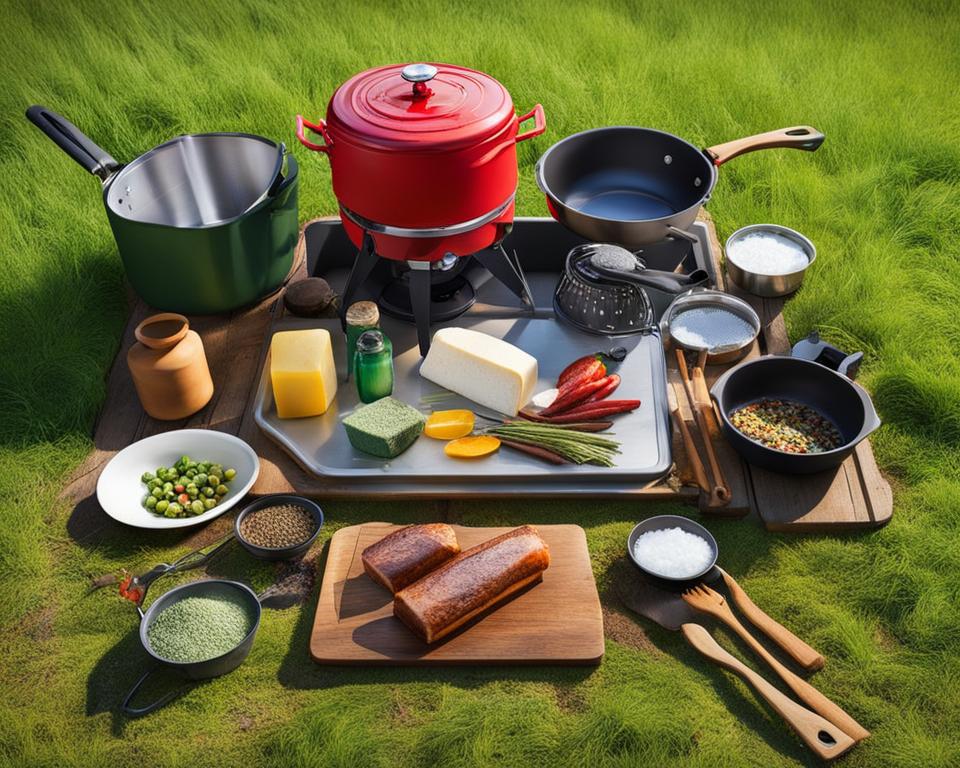
- Compact Stove: A portable and lightweight stove that’s easy to set up is essential for cooking hot meals.
- Pot and Pan: A versatile set that can be easily nested will save space and can be used for boiling, frying, and steaming.
- Utensils Set: Look for durable and heat-resistant utensils like a spoon, spatula, and tongs.
- Multi-tool: A multi-functional tool that includes a knife, can opener, and bottle opener to minimize packing numerous tools.
- Cutting Board: A lightweight and compact cutting board is crucial for food prep.
- Bowls and Plates: Collapsible options are great for saving space and can double as storage containers.
- Portable Cookware Set: A nesting cookware set often includes pots, pans, and lids which can double as plates.
| Item | Description | Space-Saving Feature | Multiple Use |
|---|---|---|---|
| Spork | A hybrid form of spoon and fork. | Merges two utensils into one. | Used for eating both liquid and solid foods. |
| Collapsible Water Container | A water holder that can be folded when empty. | Significantly reduces space when not in use. | Can store liquids or act as a washing basin. |
| Portable Coffee Press | For the coffee enthusiast on-the-go. | Typically disassembles for compact storage. | Serves as both a coffee press and drinking mug. |
To efficiently pack your essential camping utensils, consider nesting and multipurpose items that serve several functions without taking up too much room. For instance, a pot lid can double as a strainer, and a single cast iron skillet might handle the job of several pans. Keep in mind, the right selection of portable cooking tools can elevate your camping experience to a grand outdoor feast or a simple and serene dining al fresco.
Maximizing Your Multi Tool for Meal Prep
One of the most functional pieces of gear a camper can bring along is a reliable camping multi tool. The ingenious design of these versatile cooking gadgets makes them a Swiss army knife for the camp kitchen. With the right multi tool uses, you can pare down your pack weight and still have everything you need at your fingertips. It’s fascinating how these compact devices can consolidate multiple kitchen tools into one portable powerhouse.
Consider the following scenarios where a multi tool shines during meal prep:
- Peeling and slicing fruits and vegetables with an incorporated knife and peeler
- Turning meats or roasting marshmallows with fold-out fork or tongs
- Opening canned ingredients with a built-in can opener
- Uncorking a bottle of wine under the stars with an attached corkscrew
But the utility doesn’t stop there. Here’s a comparative glance at how a camping multi tool stands up against individual kitchen items:
| Multi Tool Feature | Replaces This Kitchen Item | Benefits of Multi Tool |
|---|---|---|
| Knife Blade | Chef’s Knife | Less space, versatile cutting |
| Pliers | Pot Gripper | Manage hot cooking gear without extra weight |
| Bottle Opener | Stand-alone Bottle Opener | Always at hand, no fumbling through gear |
| Scissors | Kitchen Scissors | Convenient for trimming, snipping herbs |
| Saw | Serrated Knife | Use for bread, tough-skinned veggies/fruits |
| Phillips Screwdriver | Screwdriver Set | Useful for quick gear repairs |
The adaptability of a camping multi tool means that you’ll have more space for essential ingredients and less to worry about when packing. It embodies the spirit of outdoor cooking: simplicity, efficiency, and resourcefulness.
To illustrate the effectiveness of these tools in a real-world cooking situation:
‘Hiking through the backcountry, I realized that my multi tool was not just a utensil but a companion. It opened my cans, cut my firewood, and even helped me fix my stove. Every meal was a testament to its countless uses.’
And the best part? After a long day of adventuring and cooking, clean up is a cinch. You only need to clean one tool instead of a handful of different utensils. The multi tool isn’t just about being handy; it’s about enhancing the entire camping experience.
So, next time you’re planning your gear list for an outdoor excursion, remember that a camping multi tool can be one of the most valuable, multi tool uses you include. Happy trails and even happier meals!
Nutritious Camping Diet: Planning Your Meals
Embarking on a camping trip requires careful camping meal planning to ensure you have sufficient energy to fuel your outdoor activities. A well-thought-out menu that includes high-energy camping meals is vital for maintaining stamina during hikes, climbs, and other wilderness adventures. Moreover, preserving food outdoors can be a challenge without refrigeration, but with smart choices and preparation, you can keep your food fresh and safe to eat.
High Energy Foods to Fuel Your Adventures
High-energy superfood options are imperative for sustaining your activities while camping. Focus on nutrients like complex carbohydrates, proteins, and healthy fats that offer long-lasting energy. Here’s a list that you can include in your camping meal planning:
- Nuts and seeds – Packed with protein and essential fats, they’re not only nutritious but also very portable.
- Whole grains – Brown rice, quinoa, and oats are excellent sources of complex carbohydrates.
- Jerky – A lightweight, high-protein snack that can last without refrigeration.
- Energy bars – Convenient for a quick boost when on the trail.
- Dried fruits – They offer natural sugars for immediate energy and are easy to carry.
Easy-to-Prepare Foods for Quick Meals
When your adventure-packed day calls for quick and effortless meal prep, there are numerous options you can turn to that require minimal cookware and preparation:
- Instant oatmeal – A simple, wholesome breakfast that only needs hot water.
- Pre-cooked rice or grain packets – They can be quickly reheated or eaten cold in a pinch.
- Dehydrated meals – These just-add-water meals are lightweight and come in a variety of flavors and cuisines.
- Canned beans or fish – Offering protein and fiber, they can be the base of a hearty meal.
- Peanut butter – Versatile and ready-to-eat, it goes with everything from bread to apples.
Preserving Food Freshness without Refrigeration
Keeping food fresh in the great outdoors is an art in itself. Here are some tips for preserving your food without the need for refrigeration:
- Opt for cured or smoked meats which have longer shelf lives.
- Invest in a quality, insulated cooler and freeze water bottles to serve as ice packs.
- Store perishable items like cheese or eggs in airtight containers submerged in a cold stream.
- Consider vacuum-sealed items, which can remain fresh for longer periods.
- Use perishable items first and save non-perishables for later in your trip.
Efficient Use of Heat Sources
When it comes to campfire cooking techniques, mastering the balance of flame and heat is essential for a delectable meal out in the wild. Yet, campfires are not the only game in town; portable camp stoves and sustainable outdoor cooking options, such as solar cookers, are influencing the way we prepare our food outdoors. Each heat source has its unique set of benefits and challenges, which we will explore to help you make the best choice for your camping cuisine.
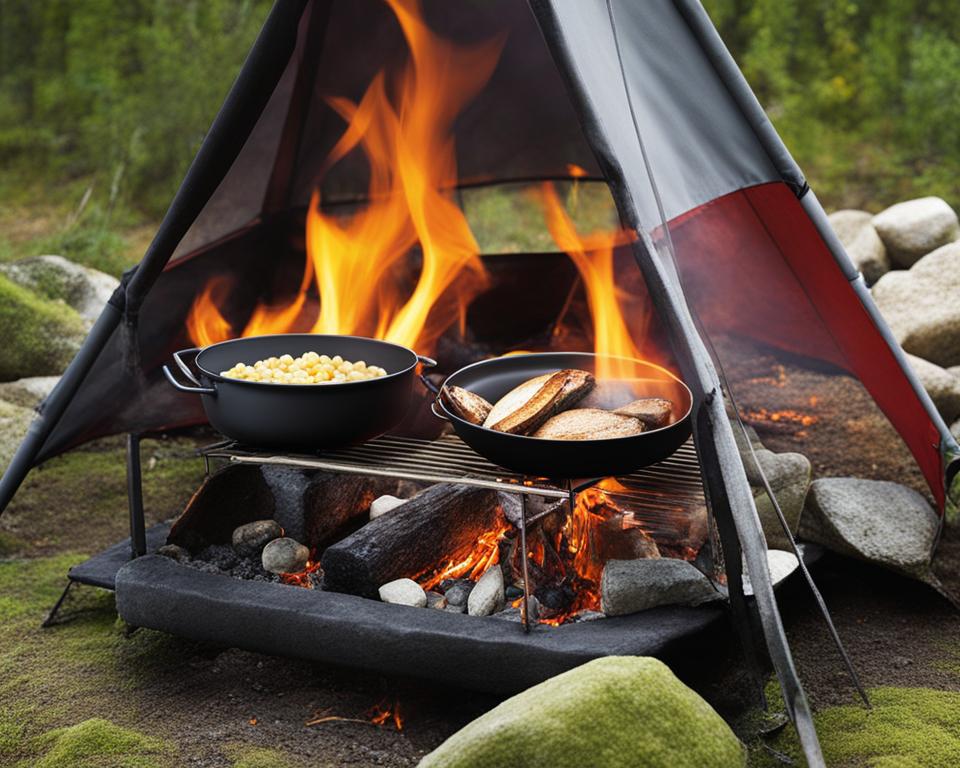
Mastering the Campfire: Controlling Flame and Heat
Building and maintaining a campfire requires skill, with factors like wood selection, fire structure, and wind direction playing pivotal roles. Effective campfire cooking techniques result in efficient fuel use and precise heat management, which is crucial when roasting, grilling, or simmering campsite meals.
Portable Stoves: Pros and Cons
Portable camp stoves are a modern convenience that can’t be overlooked. They offer reliability and control that campfires cannot, especially in environments where open flames are prohibited or impractical. Yet, these stoves come with their own considerations, including fuel availability and carrying weight.
Eco-Friendly Alternatives: Solar Cookers and More
In the pursuit of sustainable outdoor cooking, eco-friendly alternatives such as solar cookers are gaining popularity. These devices harness the sun’s energy to cook food without any fuel, reducing environmental impact and providing a unique culinary experience. However, their effectiveness relies heavily on weather conditions, which can be a limiting factor for some campers.
| Heat Source | Advantages | Drawbacks |
|---|---|---|
| Campfire | Robust flavor, traditional experience, no need for carried fuels | Requires skill, affected by weather, may be restricted in some areas |
| Portable Camp Stove | Convenient, easy to use, precise heat control | Must carry fuel, can be heavy, cost |
| Solar Cooker | Eco-friendly, no fuel required, low environmental impact | Dependent on sunny conditions, slower cooking times |
Whether you opt for the primal allure of a campfire or the modern efficiency of a portable stove, or even the ecological promise of a solar cooker, your choice of a heat source can shape your entire camping experience. The key is selecting the option that aligns with your camping style, environment, and culinary aspirations.
Safety Precautions While Cooking Outdoors
Embracing the tranquility of nature doesn’t mean foregoing safety, especially when it comes to camp cooking. This section illuminates the vital steps to ensure your culinary adventures are as secure as they are enjoyable. We’ll delve into effective fire safety protocols and introduce wildlife-proof strategies for food storage, keeping both campers and the environment safe.
Fire Safety and Extinguishing Best Practices
Ensuring your campfire does not turn into a wildfire involves vigilant preparation and action. Remember to establish your fire in a clear area away from flammable materials and overhanging branches. Using designated fire pits when available is also a key component of camp cooking safety. Once you’ve finished, execute fire extinguishing methods such as dousing the fire with water, stirring ashes, and checking for remaining embers. It’s a simple routine that can prevent grave consequences.
Wildlife Precautions: Keeping Your Food Secure
Safeguarding your provisions from curious animals is essential for a worry-free outing. Employ wildlife-proof food storage techniques by using bear canisters or hanging food out of reach. Do not leave food unattended in the open or in your tent which can attract animals. Proper food management ensures your snacks remain yours and limits human-wildlife encounters.
By adhering to these guidelines, campers can relish their meals amidst the majesty of the outdoors, while maintaining safety for themselves and the environment. Happy and safe camping to all!
Cleaning Up: Leave No Trace Behind
As advocates for the beauty and sanctity of the great outdoors, campers bear a responsibility to practice eco-friendly camp cleanup in accordance with Leave No Trace principles. This cornerstone of outdoor ethics goes beyond just picking up trash—it’s about leaving the environment as you found it or better for future nature lovers. In this section, we’ll explore the simple yet impactful ways you can ensure your campsite remains pristine.
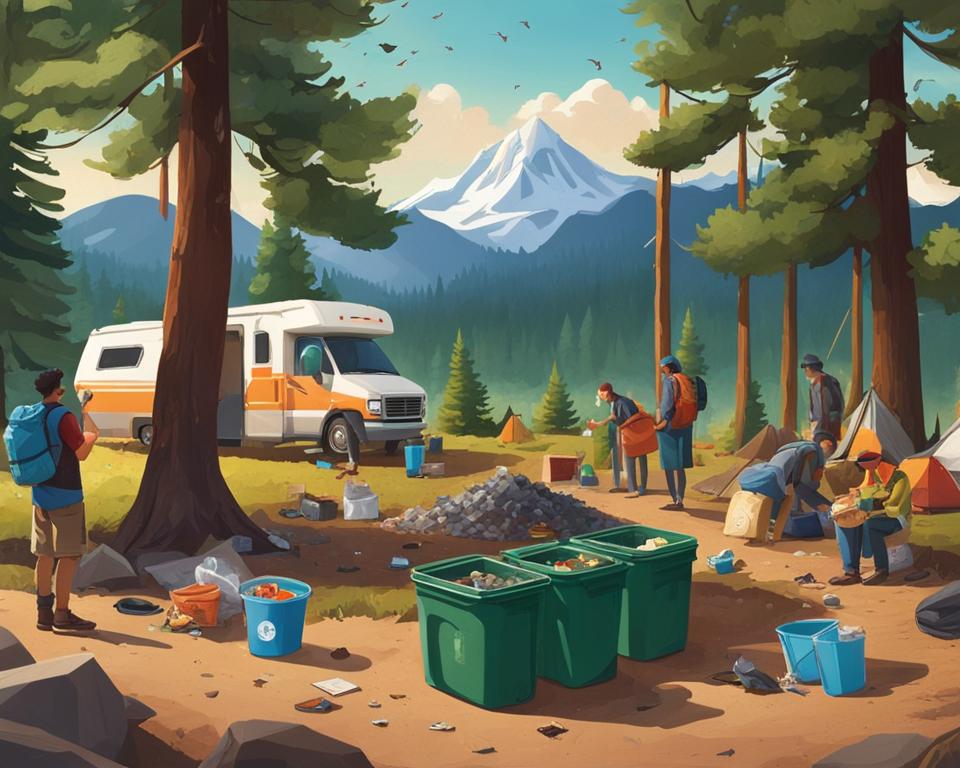
- Pack In, Pack Out: Every item you bring, from food wrappers to used batteries, should leave with you when you depart.
- Dispose of Waste Properly: All trash and leftover food must be collected and disposed of in designated areas or carried out.
- Use Biodegradable Soap for Camping: When washing dishes or yourself, opt for soaps that won’t harm the local ecosystem.
Cleaning up isn’t just about trash—it’s also about reducing the use of chemicals and products that can disrupt wildlife habitats. The role of biodegradable soap cannot be overstated; it ensures that the rivers and lakes remain pollution-free.
| Cleaning Task | Traditional Product | Eco-Friendly Alternative |
|---|---|---|
| Dish Washing | Regular dish soap | Biodegradable soap |
| Hand Cleansing | Antibacterial wipes | Natural hand sanitizer |
| Cooking Gear Scrubbing | Plastic scrubbers | Plant-based scouring pads |
Implementing these eco-conscious habits not only respects the Leave No Trace principles but also contributes to a broader culture of conservation that defines a true camper’s ethos. Remember, the most profound footprints we can leave are the ones that impact the hearts and minds of others to continue the cycle of sustainability.
Hydration Essentials: Managing Water Supply
While venturing into the great outdoors, staying hydrated is critical, but it’s not as simple as drinking from the nearest stream. Ensuring your water is clean and palatable is paramount for a healthy and enjoyable camping experience. Below, we discuss the best techniques for water purification camping and how to maintain appropriate hydration levels with useful hydration tips for camping.
Water Purification Techniques for Campers
There are multiple methods to purify water, each with its advantages. Choosing the right technique can protect you from waterborne illnesses and keep you hydrated throughout your journey. From boiling water to using advanced portable filters, here are some of the most effective and user-friendly water purification solutions you can rely on.
| Method | Description | Pros | Cons |
|---|---|---|---|
| Boiling | Bringing water to a rolling boil for at least one minute. | Eliminates bacteria, viruses, and parasites. | Requires heat source and waiting time for water to cool. |
| Filters | Portable devices that strain out impurities. | Convenient, fast, and can improve taste. | May not remove all viruses and can be costly. |
| Purification Tablets | Chemical tablets that disinfect water. | Lightweight and easy to carry. | Chemical taste; requires waiting time for effective purification. |
| UV Purifiers | Hand-held devices that use ultraviolet light to kill pathogens. | Effective against a broad range of contaminants. | Needs batteries and clear water for best results. |
Staying Hydrated with Flavorful Add-ins
Beyond purification, enhancing water taste outdoors can make hydrating far more enjoyable. Let’s review some wholesome add-ins to give your water a flavor boost without compromising on health.
- Fruit Infusions: Add slices of fruits like lemons, strawberries, or cucumbers to enrich the taste naturally.
- Herbal Teas: They can be enjoyed hot or cold and offer a variety of flavors from peppermint to chamomile.
- Electrolyte Tablets: Especially useful after intense activity, they replenish essential minerals and can come in different flavors.
Armed with knowledge of water purification and flavor enhancement, ensuring a steady, safe, and satisfying water supply is simple. Remember, these hydration tips for camping not only keep you safe but also make every sip a refreshing delight under the open sky.
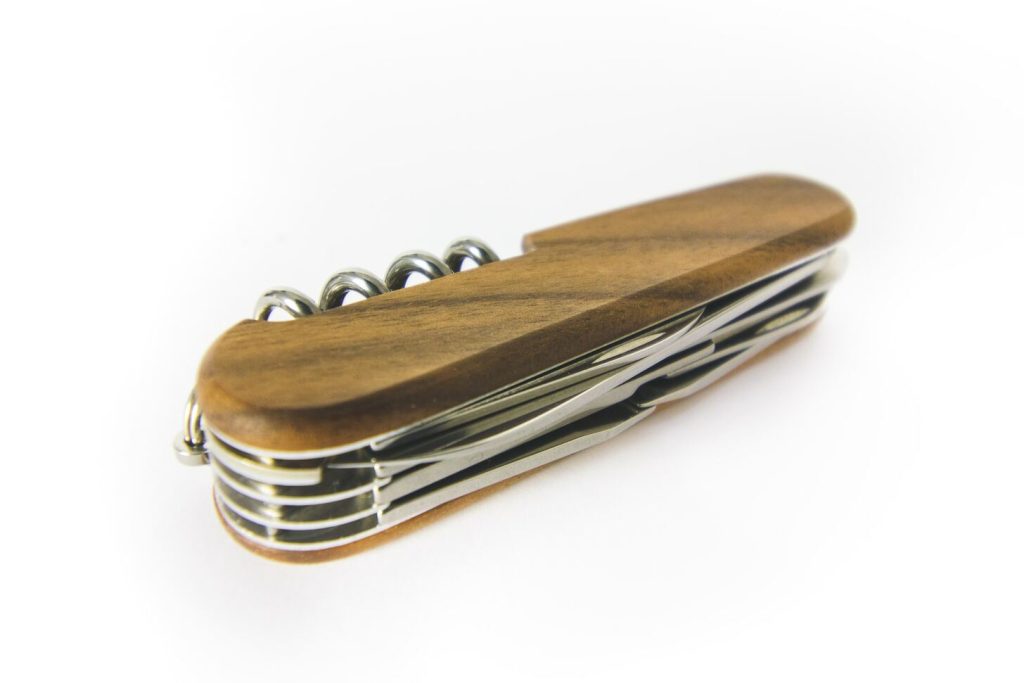
Smart Storage Solutions for Your Camp Kitchen
Efficient storage is the backbone of any well-organized camp kitchen. From corralling spices to protecting your cookware, the right storage solutions not only make cooking more pleasant but also help preserve the great outdoors. In this section, we delve into the art of storing and organizing camping equipment to maximize space and functionality, ensuring every camping adventure is both enjoyable and environmentally conscious.
Multipurpose Containers: Best Picks for Campers
Multipurpose storage containers are the heroes of organization for camp kitchen storage. Not only do they save space, but they also minimize the amount of gear you need to carry. Options like silicone collapsible containers expand when you need them and flatten for easy packing. Stainless steel containers are durable and can double as cooking pots in a pinch, reflecting the versatility that campers need.
Space-Saving Hacks: Organizing Your Gear
- Magnetic Strips: Attach a magnetic strip to the side of your cooler or campervan wall to hold metal utensils, freeing up valuable drawer and surface space.
- Hanging Organizers: Use a shoe organizer to hang on the back of a car seat or tree for easy access to kitchen tools, cutlery, and small containers.
- Nesting Gear: Invest in nesting cookware sets where smaller items can be stored within larger ones, making the most of every square inch.
With these storage strategies, campers can spend less time rummaging through their gear and more time enjoying the great outdoors. Remember, organizing camping equipment should not feel like a puzzle. With multipurpose storage containers and the right space-saving techniques, every camping trip can be a testament to your efficiency and your love for nature.
Gourmet Camping: Elevating Your Outdoor Cuisine
Unleash a world of flavors right by your tent with a dash of creativity and a sprinkle of wilderness. Gourmet campfire cooking isn’t just about the food; it’s an experience that combines the rustic charm of the outdoors with the sophistication of thoughtful cuisine. Transform your next camping trip with tantalizing campsite spices and chef-level recipes that bring out the joy of cooking under the stars.
Spices and Seasonings: Bringing Flavor to the Campsite
Forget the bland and the ordinary; a well-stocked campsite spice kit can revolutionize your open-air meals. Whether you’re grilling, sautéing, or simmering over the campfire, the right combination of herbs and spices can enhance the natural flavors of your ingredients, taking simple dishes to new heights.
| Seasoning | Description | Best Used For |
|---|---|---|
| Smoked Paprika | Rich, smoky flavor with a hint of sweetness. | Adding depth to meats, veggies, and soups. |
| Cumin | Earthy, warm tones that enhance savory dishes. | Perfect for chili, stews, and marinades. |
| Cinnamon | Sweet and woody, it adds a complex sweetness. | Great for breakfast dishes and even savory tagines. |
| Dried Oregano | Aromatic with a slightly bitter note. | Ideal for Italian and Mediterranean cuisine. |
| Sea Salt | Pure and intense, it uplifts any dish’s flavor. | An essential all-purpose seasoning. |
| Freshly Ground Pepper | Pungent and hot with a touch of earthiness. | A versatile spice for everyday use. |
Simple Yet Sophisticated Campfire Recipes
Mastering sophisticated camping recipes requires nothing more than choosing the right ingredients and a bit of campfire savvy. From fire-roasted vegetables to seared steaks, the recipes you can create are only limited by your imagination. Here are some ideas to inspire your culinary adventures:
- Rosemary Skewered Trout with Lemon Butter
- Wild Mushroom Risotto Cooked over Slow Coals
- Cedar Planked Campfire Brie with a Honey Drizzle
- Grilled Peach and Prosciutto Flatbreads
- Cast Iron Berry Cobbler with a Crunchy Topping
As you return to the serenity of the woods, remember that gourmet campfire cooking is more than just sustenance; it’s a way to enrich your outdoor experience and create lasting memories. With the right campsite spices and a repertoire of sophisticated camping recipes, your culinary campfire creations will be the envy of the wilderness.
Conclusion
As the embers of a campfire settle and the stars blanket the night sky, it is the memories of a day well-spent that truly define an unforgettable camping trip. Throughout our guide, we’ve navigated the essentials of camp cuisine, pinpointing the pivotal role of preparedness and the joy of a meal shared in the wild. We’ve armed you with the know-how for a seamless camp cooking experience, ensuring that your time outdoors is as delicious as it is adventurous.
The invaluable insights on selecting the right cookware, efficiently packing essential tools, and preparing high-energy meals serve as your roadmap to mastering the culinary aspects of camping. From the methodical use of heat sources to eco-conscious cleanup practices, every facet of outdoor dining has been touched upon to enrich your al fresco endeavors. Remember, the art of camp cooking marries utility with flavor, practicality with pleasure, building foundations for stories that traverse beyond the campsite.
Whether you’re gazing through a canopy of trees or watching the sun dip beyond a tranquil lake, it’s the taste of well-crafted meals that anchors the spirit of exploration. May the insights from our comprehensive coverage enliven your next journey into the great outdoors, promising not just a venture into nature, but a feast for the senses. Here’s to crafting every meal with intention, fostering moments that resound through the hush of the forest and the rustling of leaves – an echo of adventure, a symphony of flavors, under the endless sky.
FAQ
What essentials do I need for cooking on a camping trip?
You’ll need the right camp cooking essentials to include cookware like pots and pans, preferably made of durable materials such as cast iron or aluminum. Additionally, consider including multi-functional utensils, a portable stove or other heat sources, eco-friendly cleanup supplies, and water purification tools. Don’t forget to plan a nutritious camping diet and organize with smart storage solutions.
How do I choose the best camping cookware material?
When selecting camping cookware materials, consider durability, heat distribution, and weight. Cast iron is durable and excellent for even heat distribution, while aluminum is lightweight and heats up quickly. For easy transportation, look into collapsible options that save space.
What are some high-energy foods suitable for camping?
High-energy foods for camping should include nuts, whole grains, and protein-rich snacks like jerky or energy bars. These offer sustained energy necessary for outdoor activities. Also, think about easy-to-prepare meals like dehydrated soups and quick-cook pasta.
Can you share tips for using a multi tool during meal prep?
A multi tool can serve various functions during meal prep such as cutting, peeling, or opening cans, thus replacing several single-purpose tools. It’s handy for streamlining your cookware setup and saving space in your pack.
How do I efficiently use different heat sources while camping?
Master your campfire by learning to control the flame and heat for cooking. Alternatively, portable stoves are convenient, with various fuel options available. For an eco-friendly approach, consider trying solar cookers that harness the sun’s energy to cook meals.
What safety precautions should I take when cooking outdoors?
Always maintain fire safety by keeping flames controlled and extinguishing your fire properly. Store food securely to protect it from wildlife. It’s essential for your safety and for preserving the natural environment.
How do I manage water supply and stay hydrated while camping?
Implement water purification techniques like boiling, chemicals, or portable filters to ensure your water is safe to drink. Enhance the taste by adding flavor with fruits, or electrolyte tablets, and always be sure to carry enough to stay well-hydrated.
What are some gourmet touches I can add to elevate outdoor cooking?
Bring an array of spices and learn a few sophisticated campfire recipes to elevate your outdoor cuisine. Small additions like fresh herbs or a sprinkle of spices can transform a simple meal into a gourmet experience.
Are there eco-friendly practices for cleaning up after camp cooking?
Yes, use biodegradable soap and follow the Leave No Trace principles for cleanup. Dispose of waste properly, recycle when possible, and always pack out what you pack in to minimize your impact on the environment.
What kind of storage solutions are best for organizing a camp kitchen?
Look for multipurpose containers that can be used for both storing food and as cooking gear. Implement space-saving hacks like nesting items and using compressible bags to keep your gear organized and easy to access.

